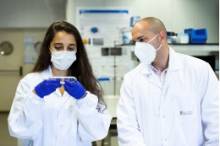Created a simulated microgravity system to experiment with materials
 Posted date: 07 Aug 2021
Posted date: 07 Aug 2021
Crystallization studies done in space laboratories, very expensive and unaffordable for most research laboratories, have demonstrated the valuable effects of microgravity during the process of crystal growth and the morphogenesis of materials. Now, research led by a scientific team from the University of Barcelona has developed an easy and highly efficient method to achieve microgravity experimentation conditions on Earth that simulate those that can be had in space. The results have been published in the journal Advanced Materials in a featured article on the cover.
To achieve these simulated microgravity conditions custom microfluidic devices have been used with which two-dimensional porous crystal molecular structures have been fabricated. According to Josep Puigmartí Luis, ICREA researcher in the Department of Physical Chemistry and member of the Institute of Theoretical and Computational Chemistry of the UB ( IQTCUB ), it has been confirmed that experiments under these conditions of simulated microgravity have effects without precedents in the orientation, compactness and generation of crystalline and porous 2D materials ”.
To develop this new system, the research team, in which members of the Catalan Institute of Nanoscience and Nanotechnology (ICN2) and the Barcelona Institute of Materials Science (ICMAB-CSIC) have also participated, designed a device microfluidic consisting of two substrates intertwined with a thin film of silicone with varying thicknesses (200 to 500 μm). The goal was to create a microfluidic environment 6 cm long and 1.5 cm wide. One of the surfaces has two mechanized entry ports that allow to completely fill the microfluidic environment and thus prevent the appearance of air bubbles. The system has made it possible to grow a prototype of two-dimensional metallurgical structure (MOF) and Ni 3 composition (HITP) 2
It should be noted that, until now, the values obtained with this new method had only been achieved outside an inert atmosphere with pellets prepared under high pressures. "This new simulated microgravity system will be like a 'playground' for chemists, physicists and materials scientists who want to process 2D materials and functional devices," concludes the researcher.
Reference Link: https://www.ub.edu/web/ub/ca/menu_eines/noticies/2021/06/043.html
Posted By

GSP Admin




